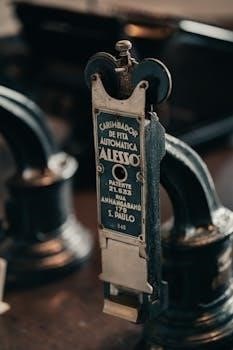
Motorcycle Transmission Basics
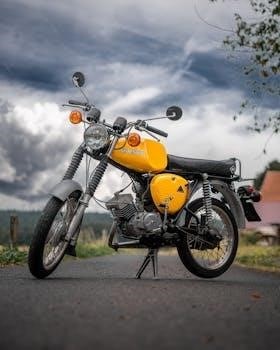
Motorcycles primarily use manual transmissions, offering riders greater control over gear selection. However, automatic options are gaining popularity, especially in scooters and some modern bikes. These systems vary in design and operation.
Definition of Motorcycle Transmission
A motorcycle transmission is a crucial system built into the bike, designed to efficiently transfer power from the engine to the wheels; Its primary function is to ensure the engine operates at its optimal RPM range, while also providing the necessary torque for various riding conditions. The transmission also incorporates a clutch system for safe engagement and disengagement of power. It allows the rider to select appropriate gear ratios for acceleration, cruising, and deceleration. Different types of transmissions exist, including manual, automatic, and semi-automatic, each with unique operating mechanisms and advantages, catering to diverse rider preferences and motorcycle applications. The transmission also ensures a connection to the wheels at the correct rpm.
Manual Motorcycle Transmissions
Manual transmissions, also known as standard transmissions, are common in motorcycles. They require the rider to manually change gears using a hand-operated clutch and foot-operated gear lever.
Sequential Gearboxes in Manual Transmissions
Most manual motorcycles feature a sequential gearbox. This means that gears must be shifted in numerical order, moving from first gear to second, then third, and so on. Riders cannot skip gears or shift directly to a higher or lower gear. This design is common in five and six-speed transmissions, though some smaller bikes might have four-speed versions. The sequential nature of the gearbox ensures that the transmission operates smoothly, allowing for a controlled transfer of power through the gears while riding. It is different from a car’s shift gate, which allows for direct gear selection.
Operation of a Manual Motorcycle Transmission
A manual motorcycle transmission is operated using both a foot-operated gear shift lever and a hand-operated clutch lever. The rider engages the clutch to disengage the engine from the gearbox, then uses the foot lever to select the desired gear. Releasing the clutch lever then engages the gear. This process allows for the smooth transfer of power from the engine to the wheels through different gear ratios. Most manual transmissions use a multi-plate wet clutch. This system is quite different from a car’s and requires practice to master. The rider must coordinate clutch, throttle and gear selection for smooth operation.
Automatic Motorcycle Transmissions
Automatic motorcycle transmissions offer a simplified riding experience by removing the need for manual gear changes. These systems use various mechanisms like CVT and DCT to smoothly transfer power.
Continuously Variable Transmissions (CVT) in Motorcycles
Continuously Variable Transmissions, or CVTs, are commonly found in maxi-scooters, offering smooth and efficient power delivery ideal for urban environments. Unlike traditional gearboxes, CVTs use a belt and pulley system to provide an infinite number of gear ratios. This allows the engine to operate at its most efficient RPM, resulting in seamless acceleration without the need for gear shifting. The rider experiences a more effortless and convenient ride, making CVTs a popular choice for those seeking ease of use. The absence of distinct gear changes contributes to a smoother riding experience.
Dual-Clutch Transmissions (DCT) in Motorcycles
Dual-Clutch Transmissions, often abbreviated as DCT, represent a middle ground between manual and automatic systems. They utilize two separate clutches, one for odd-numbered gears and another for even-numbered gears. This design enables rapid and seamless gear changes as the next gear is pre-selected and ready to engage, minimizing power interruption. DCT systems can operate in a fully automatic mode, or allow the rider to manually shift through the gears using buttons or paddles. This provides a versatile riding experience that combines the convenience of automatic operation with the control of manual shifting. DCTs are increasingly popular in modern motorcycles, offering a sporty yet user-friendly option.
Semi-Automatic Motorcycle Transmissions
Semi-automatic transmissions, also known as auto-clutch or clutchless manual transmissions, offer a blend of manual and automatic features. These systems eliminate the need for a clutch lever.
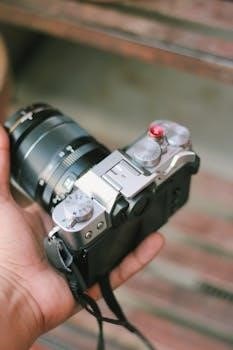
Clutchless Manual Transmissions
Clutchless manual transmissions, a type of semi-automatic system, allow riders to shift gears without using a clutch lever. This is achieved through various mechanisms, often involving sensors and actuators that automatically disengage the clutch during gear changes. While the rider still initiates gear changes, the system handles the clutch engagement, simplifying the process. These systems are sometimes called auto-clutch transmissions and provide a more convenient option for some riders. Some racing vehicles also use similar systems where the rider input is still required to shift gears.
Historical Overview
The first manual motorcycle transmission appeared in 1885. The first automatic motorcycle was the Hondamatic in 1979. These historical developments mark key points in transmission technology.
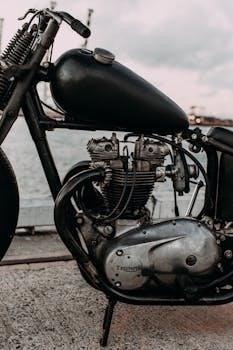
Early Automatic Motorcycles
Early automatic motorcycles, such as the Honda CB750A and CM400A, were notable exceptions to the prevalence of manual transmissions. These models, though not widespread, demonstrated the feasibility of automatic systems in motorcycles. They often utilized a two-speed transmission, a significant departure from the five or six-speed manual gearboxes. These early automatic designs aimed for ease of use and were often targeted at riders seeking simplicity. Despite limited adoption, these early efforts paved the way for more advanced automatic motorcycle transmission technologies, like CVTs and DCTs, that are gaining traction today. These early models faced challenges in performance.
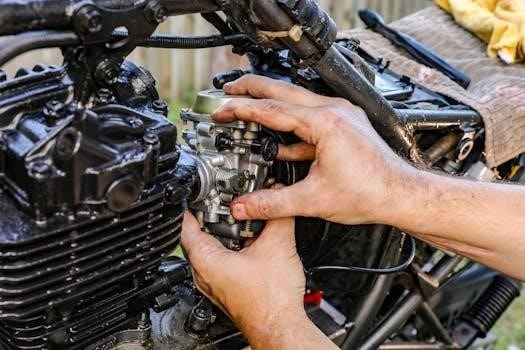
Gear Types and Ratios
Motorcycle transmissions utilize fixed, freewheeling, and slider gears. Each gear ratio is composed of two constantly meshed gears, with a six-speed having twelve gears total.
Fixed, Freewheeling, and Slider Gears
Motorcycle transmissions incorporate three primary gear types⁚ fixed, freewheeling, and slider. Fixed gears are permanently meshed and provide a direct drive ratio. Freewheeling gears allow rotation in one direction but disengage in the opposite, crucial for smooth shifting. Slider gears move along the shafts to engage different gear sets, changing the overall gear ratio. These gears work together to provide the various speeds and torque needed by the motorcycle. Typically, two constantly meshed gears create each gear ratio. A six-speed transmission would therefore have twelve gears. The interaction of these gears is critical for the motorcycle’s performance and the rider’s control.
Final Drive Systems
The final drive system transmits power from the transmission to the rear wheel. Common systems include sprockets and chains, which efficiently transfer torque while being relatively simple and easy to maintain.
Sprockets and Chain System
In the sprocket and chain system, a smaller front sprocket, driven by the transmission, transfers power to a larger rear sprocket on the wheel via a metal chain. This mechanical linkage is a common method for delivering rotational force to the rear wheel; The system’s effectiveness depends on proper lubrication and tension adjustments. The chain transfers the engine’s power to the rear wheel and allows for variations in gearing ratios. This system is widely used because of its simplicity, efficiency, and relative ease of maintenance compared to other drive systems. The chain requires regular care to ensure smooth operation and longevity.